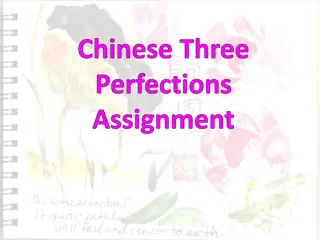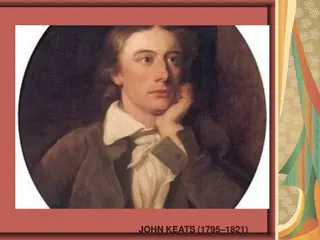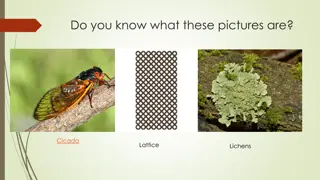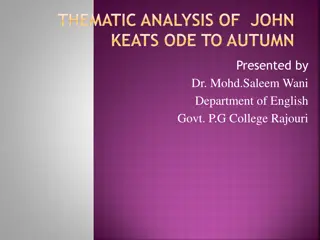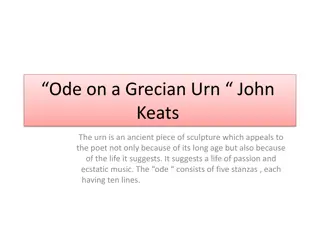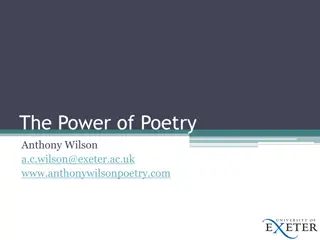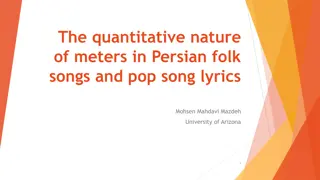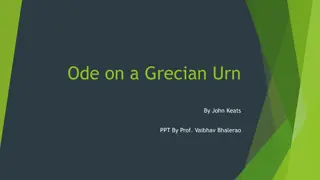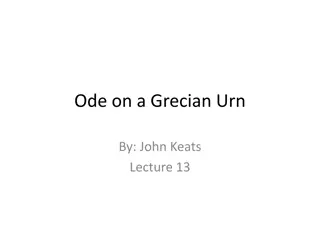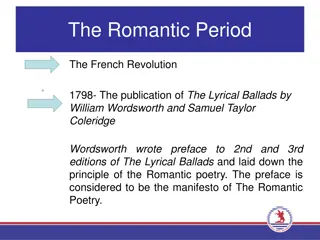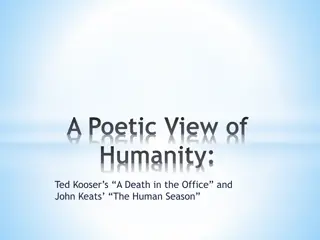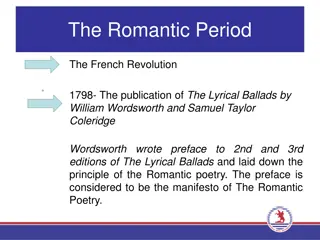The Life and Poetry of John Keats: A Master of Beauty and Mystery
Born in 1795, John Keats faced early hardships and pursued poetry despite a medical background. His exquisite Odes reflect a profound aesthetic sense. Keats' life was tragically cut short by tuberculosis in 1821, leaving behind a legacy of beauty, truth, and negative capability in his work.
Download Presentation

Please find below an Image/Link to download the presentation.
The content on the website is provided AS IS for your information and personal use only. It may not be sold, licensed, or shared on other websites without obtaining consent from the author. Download presentation by click this link. If you encounter any issues during the download, it is possible that the publisher has removed the file from their server.
E N D
Presentation Transcript
John KEATS KEATS
Life Born in London in 1795 in a middle-class family, he became orphan at the age of 15. He apprenticed to a surgeon to support his family but continued writing because he wanted to become a poet. In 1816 (age of 21) he met the poet Leigh Hunt, who helped him develop his talent; he interrupted his medical studies and in 1817 he published his first poems.
In 1818, he had a tour of Lake District and Scotland. When he came back, he took care of his brother, who was dying of tubercolosis. In the years 1818-9 his best works (like La belle Dame sans Merci and the Great Odes: Ode to Psyche, Ode to a Nightingale, Ode on a Grecian Urn, Ode on Melancholy, Ode on Indolence, Ode to Autumn) were completed. However, in 1820 he fell ill will tubercolosis. He left Fanny Browne, with whom he had been in love for 2 years, and went to Italy to recover, but died in Rome in 1821.
STYLE It has been said that when he died, his poetry had reached such a perfection that not even Milton or Shakespeare could be compared to him at his age (25). In his Odes (composed in 1819) we can find: 1) Slow and reflective rhythm 2) Drawing on all senses in order to convey an experience 3) Rich and refined language 4) Clever use of imagery.
In his letters, he reflected on contradictions: 1) He felt love but could see only death 2) He was attracted by the imaginative world of art and dreams but at the same time he was concerned about social responsibilities.
Centrality of BEAUTY For Keats, art is connected to BEAUTY. The contemplation of beauty is central in Keats works, especially beauty around him. Beauty could reveal the essential TRUTH of THINGS and for KEATS, BEAUTY is EQUAL to TRUTH. "Beauty is truth, truth beauty, that is all Ye know on earth, and all ye need to know. (tautological sentence) BEAUTY IS A FORM OF KNOWLEDGE.
The poets role: NEGATIVE CAPABILITY Negative capability is when a man is capable of living of UNCERTAINTIES, mysteries and DOUBTS without having to search for fact or reason . It s the capacity of the artist to reserve judgement on his source of inspiration, NOT TO EXPLAIN, but TO EXPLORE the mysteries of life. The important thing is NOT the logical UNDERSTANDING, to explain or judge something, but RENDERING ITS BEAUTY. The poet is not imprisoned in rational doubts, he accepts mysteries and trusts his visions of beauty.
IMAGINATION and TRUTH Using his negative approach, the poet can bring his imagination to a higher perception of reality, which Keats calls TRUTH. Truth is like an EPIPHANY, a revelation which remains intact even after the source of imagination disappears. He was the forerunner of the Aesthetic Movement, which put the Art for Art s sake at its center.
Ode on a Grecian Urn Thou still unravish'd bride of quietness, Ah, happy, happy boughs! that cannot shed Your leaves, nor ever bid the Spring adieu; Thou foster-child of silence and slow time, And, happy melodist, unwearied, Sylvan historian, who canst thus express For ever piping songs for ever new; A flowery tale more sweetly than our rhyme: More happy love! more happy, happy love! What leaf-fring'd legend haunts about thy shape For ever warm and still to be enjoy'd, For ever panting, and for ever young; Of deities or mortals, or of both, All breathing human passion far above, In Tempe or the dales of Arcady? That leaves a heart high-sorrowful and cloy'd, What men or gods are these? What maidens loth? A burning forehead, and a parching tongue. What mad pursuit? What struggle to escape? Whoare these coming to the sacrifice? What pipes and timbrels? What wild ecstasy? To what green altar, O mysterious priest, Lead'st thou that heifer lowing at the skies, Heard melodies are sweet, but those unheard And all her silken flanks with garlands drest? Are sweeter; therefore, ye soft pipes, play on; What little town by river or sea shore, Not to the sensual ear, but, more endear'd, Or mountain-built with peaceful citadel, Pipe to the spirit ditties of no tone: Is emptied of this folk, this pious morn? And, little town, thy streets for evermore Fair youth, beneath the trees, thou canst not leave Will silent be; and not a soul to tell Thy song, nor ever can those trees be bare; Why thou art desolate, can e'er return. Bold Lover, never, never canst thou kiss, O Attic shape! Fair attitude! with brede Though winning near the goal yet, do not grieve; Of marble men and maidens overwrought, She cannot fade, though thou hast not thy bliss, With forest branches and the trodden weed; For ever wilt thou love, and she be fair! Thou, silent form, dost tease us out of thought As doth eternity: Cold Pastoral! When old age shall this generation waste,







